Maelgwn duly does make an oath now, though it's framed in the Christian telling as promises of atonement for being naughty.
He commits to giving land and funding for Tydecho's Church, though that's suspect, given that Mawddwy wasn't in Gwynedd in the 6th century and therefore not Maelgwn's territory to donate. It may be an element added later to provide more weight to his contrition, or to add a date of 520 CE to the telling.
The Gwynedd ruler furthermore swears to uphold 'the privilege of sanctuary for a hundred ages so that neither man nor beast could be taken from his land; no battles, or burning, or killing to be admitted there.'
In other words, a sacred place where everything runs wild and free. No social constraints. Peace.
Could this be why the legends also tell us that Maelgwn didn't fight at Camlan? He arrived with an army, which Arthur expected to help him win the day. But instead Maelgwn remained stationed in Brithdir, just across the valley, possibly condemning Arthur by inaction.
Finally Tydecho allows Maelgwn to rise from the blue stone Gorsedd. Every bard, however enlightened, has to enter the world again. Unmentioned, but a logical progression, is Tydecho's final role in the shamanic journey.
The gatekeeper - the House of Twilight - has two dwellings. Himself, and the place at the foot of the mountain. This is the final location for an initiate, a resting place for quiet contemplation, or a halfway house between the Otherworldly realm and reality.
That this is marked by a standing stone, within a grove of ancient yew trees, enclosed by the churchyard walls of St Tydecho's Church, shows just how long this has been a sacred site. Three religious eras encased around each other, like layers in the same, old story.
Representing the focal point for a Christian tale, embedded with Druidic symbolism, incorporating ancient monuments which were built to serve an older religion yet.
As for Tydecho and Tegfedd, they might be Christian saints terribly slandered by fertile imagination. But if not, then might they be more than a God and Goddess of the Druids, reconstructed through history and inspired visions?
Could they even represent some distant memory of ancestral deities? Filtered through two religions from another, that we couldn't even begin to reconstruct. Perhaps one where the Wild Hunt held real and present danger, and the fair graves were filled, but the promised reward was worth lugging a heavy blue stone, all the way from Caer Angli, to a spot halfway up a mountain in Mawddwy.



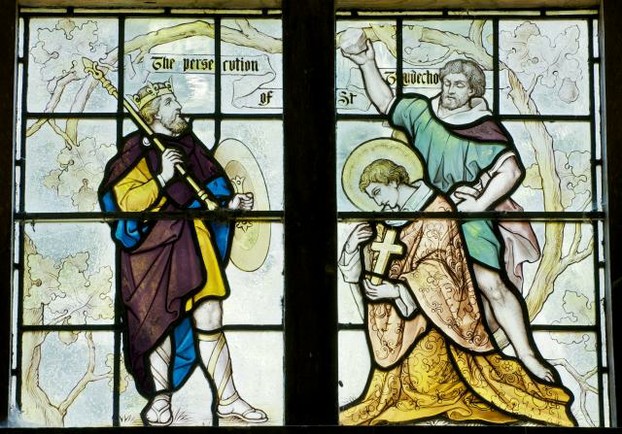




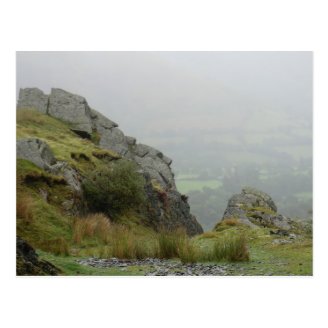









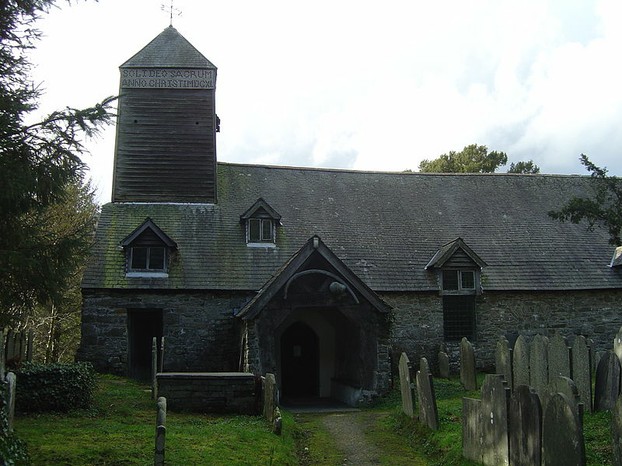






























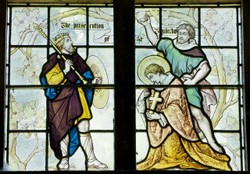

 Goodies for an Outlander Premiere Partyon 03/06/2015
Goodies for an Outlander Premiere Partyon 03/06/2015
 Holocaust Memorial Day Interview with Rainer Höss, Grandson of Rudolf Architect of Auschwitzon 01/24/2015
Holocaust Memorial Day Interview with Rainer Höss, Grandson of Rudolf Architect of Auschwitzon 01/24/2015
 Romantic Valentine Gifts for an Outlander Fanon 01/16/2015
Romantic Valentine Gifts for an Outlander Fanon 01/16/2015

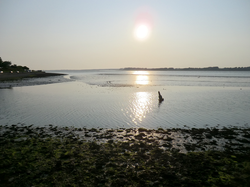
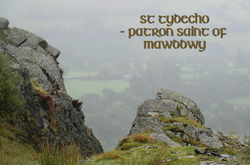
Comments
Having now been there, I can confirm the number/location of the churches: Llanmawddwy, Mallwyd, Garthbeibo, Cemmaes and one which no longer exists on the mountain ridge above Aberangell. The first is closed down/abandoned, though not in ruins. Mallwyd and Cemmaes have their doors unlocked, so you can go inside. Though the notices concerned the Church in Wales, the set up inside both looked Catholic. We unfortunately missed Garthbeibo, as it wasn't signposted from the main road, and time constraints forbade going to hunt for it.
Llanymawddwy is right next to Dinas Mawddwy. The name alone suggests that there was once a dinas up there - Iron Age 'city' - and the archaeology is there to confirm it. Incidentally, there was once a huge lake too - Llyn Mawddwy - but that's disappeared over the centuries. You can still see the shape of the shoreline though.
The Green Lady, in this instance, followed after the Gwyllidian Coch Mawddwy - red-haired bandits who some think were a real Tudor period human clan, and others think were fairy. I'm currently sitting firmly on the fence with that one, as there's evidence either way.
Green ladies are normally associated with castles, unless they are the only ones mentioned in the books. Was the house a manor house or an ancient building? These accounts confirm my vew that there is more to place than merely physical configuration.
Ah! I suppose that the clue was in the name.
We've definitely nailed this, but I'm still coming up with stuff. It hadn't even occurred to me yet to check the area against the fairy legends. They're there. In abundance. We even have the Green Lady visiting a local house, and a whole horde of preternatural robbers.
Plus some suggestion that the Mallwyd church was positioned thus through supernatural guidance, but I'm yet to pin down that story. It's vicars have been some of the most important writers, translators and bards in Welsh history! (Ab Ithel for a start, translator of 'Y Goddodin')
A chapel of ease! I should have known it. A church in a large parish might have an outlying chapel some miles away so that the minister can visit local congregations to give services, allowing them not to travel to the distant church. This is a chapel of ease.
Lying in a stone bed [grave] for three days and nights is a symbolic death; and rebirth follows. Heroes are in mythology twice born. The hero/king descends into the tomb/underworld for three days and returns to overcome death. It is only thus that having been reborn he can be a hero. Aengus Og at Newgrange went into the barrow, the womb of the goddess, and was reborn.
Thank you for looking. I was wondering what was so unusual about it! The Cemmaes one used to have 'several enormous' yew trees, but most they were cut down in the 18th century. It doesn't tell us if they were arranged in a grove.
I thought that the three were: Mallwyd/Mawddwy, Cemmaes and Garthbeibo, with the last one being a chapel of ease for Mallwyd. Is that different to a church in any notable way?
I'm currently finding some interesting correlations between the Maelgwn story and Aengas Og at Newgrange. Particularly in the fact that they seem to be repeating the same oath AFTER a king has lay in a stone bed (Gwely Tydecho shades here) for three days and three nights.
I'm getting more convinced by the second that we're right here. Definitely Pagan origins.
I have just looked and found two. The one at Mawddwy in the St Asaph diocese is sometimes described as being at Mallwyd and elsetimes at Mawddwy. This leads people to think that there are three, unless there is a third that I have missed.
Both churches are built on the site of a sixth century church, which was demolished for the newer build. The Mawddwy one has a slightly elongated design, which renders it a bit unusual [this is the one with mammoth bones.] In each case the sixth century church is lost. The evidence that they are originally pagan sites is that in each case the church yard is a bit unusual: the one in Bangor dioscese has a semicircular enclosure [a henge?] and the other a hexagonal one. Slightly odd for a church yard, but not very odd. The one in Mawddwy has an the remains of an earthwork nearby, the wall of which slopes down behind and away from the church, and as Mawddwy is on a rockey outcrop this could well be the site of a hill top henge. There could well be churches built into henges and other sacred enclosures.
Each churchyard has ancient yews indicating a pagan sacred place. At Cemmaes in Bangor diocese there are four of them, each very old, the oldest being near the lychgate, where corpses would be brought in, and there are three younger ones. I am unsure what to make of this. The one at Mawddwy has two holy wells nearby. This is another indication that it is a pagan site. One site has a boulder with a hole in it in the graveyard. This is a known kind of megalith.
Beyond this there seems to be nothing unusual about the churches. They were definitely constructed on ancient pagan sites.
Since replying last time, I've also made a discovery. There are two MAMMOTH bones above the doorway in St Tydecho's Mallwyd church. I'm not just talking big bones, but actual mammoth bones. How cool is that? And yes, lovely touch regarding his possible antiquity, except they were only added there in 1914.
I've also called into doubt my own translation of Tydecho's name. The trouble is that 'decho' isn't actually a Welsh word. I'm now wondering if 'dechreu' is a closer fit - 'beginning' or 'originate' or 'to commence'. If so, then I'll have to go over my links to see if the scenario that I painted still fits.
I do like your linking them to an bodak agus an cailleach. I'm certainly familiar with the second of those names, and yes she fits beautifully with how I was aligning Tegfedd. I'll follow your lead with the coupling.
I agree with all else that you've said.
It might be worth you searching the internet for St Tydecho's churches (there are three), as I keep coming across references to them being unusual, without much information as to why. Thanks in advance.
Having re-read this article I am convinced that we are dealing with a pair of neolithic deities. Tydecho is an elemental male: hair-covered and thus the embodiment of primitive, wild masculinity. I therefore suspect that he was a fertility deity, and that would make Tegfefdd his mate. She was no nun! These are a local embodiment of the deities that the Gaels called an bodak agus an cailleach, the old man and the old woman. This pair of deities had different local names across Europe, and are part of the Vanir. You know them as the Lord and the Lady.
There are other neolithic and bronze age elements here. The barrows and the mothers are ancient. The matrones [mothers] are triple goddesses shown in engravings right into the Roman period, when they had their own festival. As for the significance of blue stones, think Stonehenge. Blue stones from South Wales were shunted across to Wiltshire for their ritual use. This shows that they were valued in the neolithic. You are right to think of the barrows as representing belief in reincarnation, return to the womb of the mother. Goddess faiths tend to lead to belief in reincarnation,as returning to the goddess is returning to the womb.
There is still a shrine to an bodak agus an caiileach in Glen Lyon, which is tended by a local shepherd. Scottish fisherman used to stop at the island Gigha where they would seek luck from this pair and their daughter at an ancient shrine
I suspect that a monk re-rote the ancient tale as Christian, but as you said, the simple account in which Britian turns completely Christian over a few centuries was never historically valid.
Hell, in that sense, is actually more akin to the Norse Helheim than anything described by Dante.
While you're feeling suspect about early saints from a Catholic prospective, us Pagans are certainly guilty of seeing old Gods concealed in them all. There was a real push to reclaim them a while ago, followed by the inevitable backlash from scholars telling us off about it.
To my mind, a few did creep in there - and I'm fairly certain that Tydecho and Tegfedd fit the bill - but the vast majority really were human beings and Christians too. However, it does appear that you couldn't pick up a prayer book in 6th century Wales without being made a saint! And those who did weren't above nicking a few Pagan elements to enrich their miraculous stories.